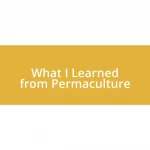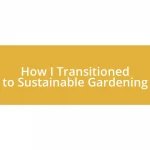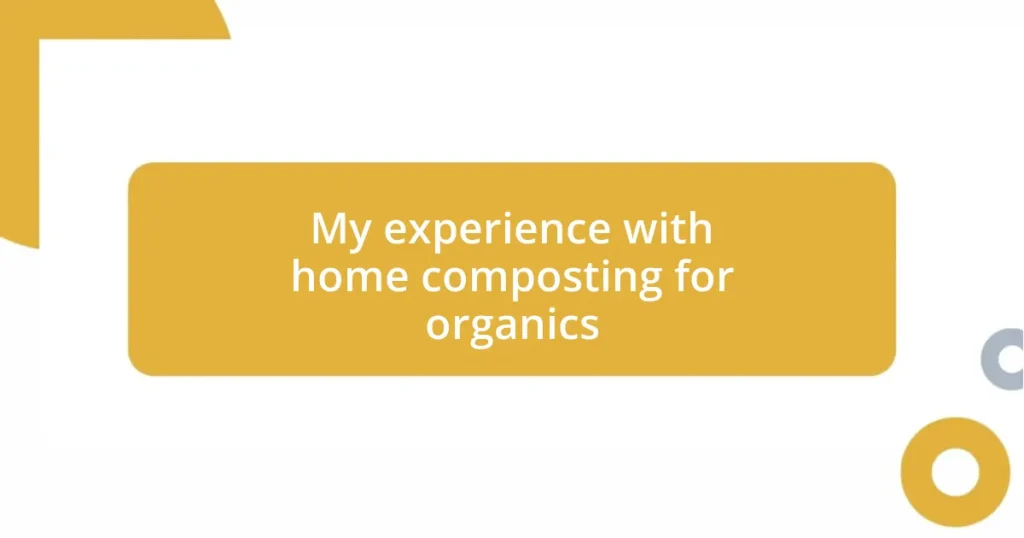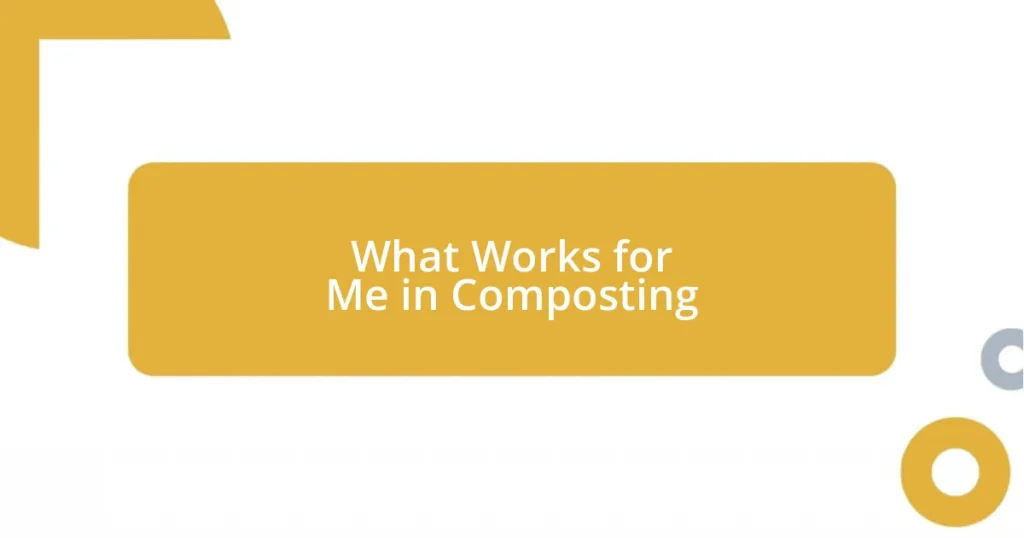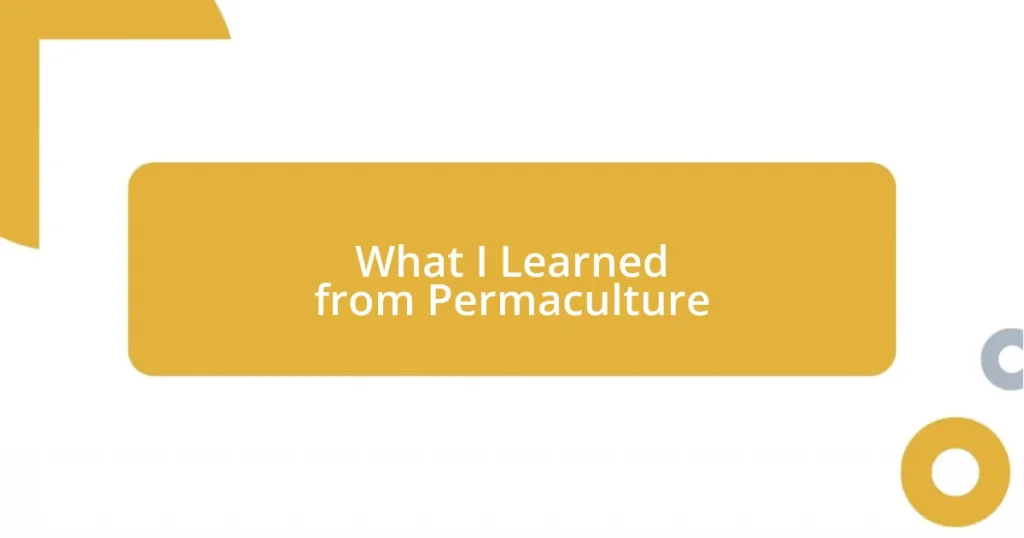Key takeaways:
- Various composting methods, such as traditional piles, worm composting, and Bokashi, can cater to different needs and living situations.
- Home composting significantly reduces waste, enhances soil health, and contributes to environmental sustainability.
- Choosing the right compost bin and maintaining a balanced mix of materials are crucial for effective composting.
- Utilizing finished compost in gardening enriches the soil and promotes healthier plant growth, creating a rewarding gardening experience.

Understanding home composting methods
When I first started composting, I had no idea there were several methods to choose from. There’s the traditional pile method, which I found to be a bit messy and time-consuming with all that turning and aerating. Then I stumbled upon worm composting, or vermicomposting, and I was hooked! Using worms to break down my scraps felt like alchemy—it was both fascinating and rewarding.
I’ve also dabbled in using compost bins, which can be a game changer for those who want a more contained process. They keep things tidy, and it amused me to see my little “black gold” factory churning out nutrient-rich compost right in my backyard. Have you ever watched your kitchen waste transform into something magical? It’s truly an eye-opener! The satisfaction of seeing how those vegetable scraps evolve into compost brings a sense of fulfillment unlike anything else.
Finally, there’s the Bokashi method, which I initially thought was too complex. But after giving it a shot, I realized it’s incredibly efficient. It uses fermentation to break down food waste, making it suitable for even cooked items. The added benefit of not needing a large outdoor space is a bonus for someone like me, living in a small apartment. Isn’t it amazing how many ways we can contribute to the environment right from our homes?

Benefits of composting at home
Composting at home has enriched my life in ways I never imagined. Not only does it help reduce the amount of waste I send to landfills, but it also transforms that waste into something profoundly useful. The first time I sprinkled my homemade compost into my garden, I felt a surge of pride. Watching my plants thrive, nourished by scraps that would have otherwise gone to waste, was downright magical.
Here are some fantastic benefits I’ve experienced from composting at home:
- Reduced Waste: I’ve significantly cut down on my trash output, which feels rewarding.
- Nutrient-Rich Soil: My garden flourishes with the organic compost, leading to healthier plants and a more vibrant garden.
- Cost-Effective: I save money on fertilizers and soil amendments while providing my plants with natural nutrients.
- Environmental Impact: By composting, I’m doing my part in reducing greenhouse gas emissions, which is incredibly fulfilling.
- Educational Experience: It’s a continuous learning journey; every batch teaches me more about nature’s cycles.

Choosing the right compost bin
When it comes to choosing the right compost bin, I’ve learned that not all bins are created equal, and each type offers its own unique advantages. For instance, I used a simple plastic bin for my initial composting endeavors. It was durable and straightforward, making it easy for me to toss in my kitchen scraps without fuss. Over time, however, I found that a more sophisticated rotating bin suited my needs better. The ease of aeration made a noticeable difference in the speed of composting, which was incredibly satisfying.
I also discovered that size matters when selecting a compost bin. In my small backyard, a compact bin was essential. I made the mistake of opting for a larger bin initially, thinking it would accommodate future waste, but I quickly realized it dominated the space and became inconvenient. A smaller bin not only blended well with my garden but also reminded me to keep my inputs manageable. Have you thought about how a compost bin could fit into your living space?
Lastly, there’s cost to consider. While some bins can be pricey, I found that investing in a good-quality composter can save you money on fertilizers in the long run. After trying a mid-range rotating bin, I can confidently say the initial investment was well worth it. The rich compost I produced not only nourished my plants but also eased my financial burden when it came to buying soil amendments. Choosing the right compost bin is really about finding one that fits your lifestyle, needs, and budget.
| Bin Type | Pros |
|---|---|
| Plastic Bin | Budget-friendly, easy to use |
| Rotating Bin | Faster composting, easier aeration |
| Worm Bin | Great for small spaces, produces high-quality compost |
| Bokashi Bin | Ferments food waste, suitable for small spaces |

Best materials for composting
When it comes to composting materials, I’ve found that variety is key. My best results come from balancing “greens” and “browns.” Greens include things like fruit scraps, vegetable peels, and coffee grounds, which provide nitrogen. I remember the first time I added coffee grounds; the earthy smell and texture they brought to my compost were wonderful. On the other hand, browns—like dried leaves, straw, and shredded paper—add carbon and help maintain the right balance. Have you ever considered how just a small change in your materials can positively affect your composting process?
While exploring the best materials, I stumbled upon a few unexpected winners. Eggshells have been fantastic; throwing them in made me feel like I was adding a little extra calcium to my garden. Plus, they crush easily and decompose well, which is a bonus. However, I learned to avoid oily or greasy foods, as they might attract pests and create a bit of a mess. Trust me, managing fruit flies is not something you’d want in your composting journey.
From my experience, I recommend keeping a dedicated bin for kitchen scraps. I often whisk away my veggie scraps after dinner and it’s almost a ritual at this point—each toss feels satisfying. Keeping a good mix ensures the compost breaks down efficiently, so being mindful of what you’re adding really pays off. Have you thought about the role of each material you put in your compost? This mindfulness not only enhances the compost quality but also makes the entire process feel more intentional and fulfilling.
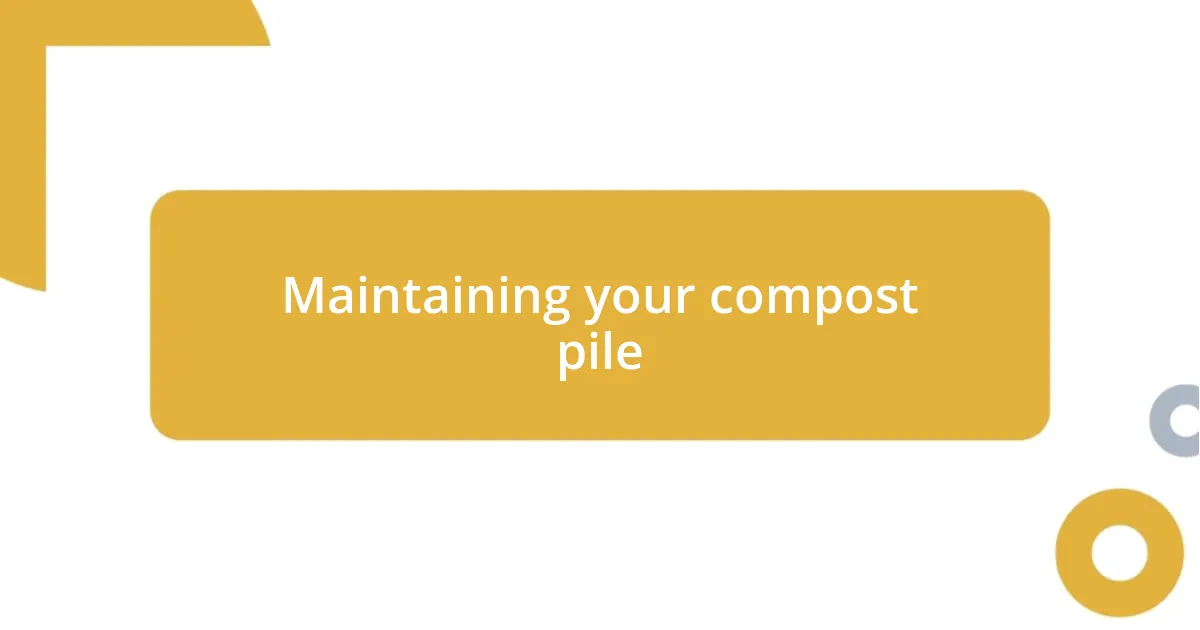
Maintaining your compost pile
To maintain your compost pile effectively, it’s essential to turn it regularly. I remember my first attempt—after a few weeks, I opened the bin, and it resembled a compact swamp! This taught me the importance of aeration. Turning the pile every couple of weeks allows oxygen to reach the microorganisms that do the hard work of decomposition. It also helps mix in fresh materials and promotes faster breakdown, leading to that rich compost we all desire.
Moisture levels are another crucial aspect. During dry spells, I noticed my compost pile wasn’t breaking down as quickly. It felt a bit like a neglected garden—half-hearted and uninspiring. I learned to check the moisture by grabbing a handful; it should feel like a damp sponge, not dripping. A little sprinkle of water can work wonders! Are you keeping an eye on your pile’s moisture? Keeping a balanced humidity level helps speed up composting and prevents unpleasant odors.
Finally, watch out for temperature changes in your pile. On occasions when I felt a heat emanating from my compost, it was a sign that microbial activity was thriving. That moment brought a smile to my face; it felt like I was nurturing a living ecosystem. If it gets too hot, though, don’t panic. This could indicate it’s time to add more browns or turn the pile to cool it off. Understanding these subtle signs makes composting not just a chore, but a rewarding connection with my garden. How has your experience been with managing your compost pile’s heat?

Troubleshooting common composting issues
I’ve certainly faced my share of composting challenges, particularly when I noticed my pile wasn’t heating up as it should. It was almost discouraging, watching my efforts stall. I learned that sometimes, adding a few handfuls of fresh greens can provide the kick of nitrogen needed to spark microbial activity. Have you ever felt that frustration? A quick fix can lead to that rewarding warmth and transformation we strive for in composting.
Another common issue I’ve encountered is unpleasant odors, which can be quite disheartening. Initially, I was taken aback when I opened my compost bin to an overpowering smell; I mistakenly thought I was doing everything right. Through trial and error, I discovered that I had been adding too many greens and not enough browns. Balancing these materials and ensuring proper aeration with regular turning made a world of difference. Have you had to troubleshoot this particular issue? A little adjustment can turn that odor into a delightful earthy scent.
Sometimes, pests can become unwelcome visitors in your compost pile, and it’s something I dread. The first time I found a trail of ants, it felt like I was under siege. This experience taught me the importance of keeping food scraps well-contained and avoiding certain attractants. Did you know that burying kitchen scraps deep within the compost can help deter pests? It’s a simple yet effective tactic I now rely on, transforming my composting experience into a more peaceful one.

Utilizing finished compost in gardening
Utilizing finished compost in gardening is one of the most satisfying aspects of composting. When I first started applying my compost to the garden, I was amazed at how much it transformed my soil. I remember spreading it around the base of my tomatoes and watching them flourish beyond my expectations. It’s like giving your plants a natural boost of nutrients—why wouldn’t you want to share that goodness with your garden?
After several seasons of composting, I’ve learned to blend the finished compost into the existing soil rather than just placing it on top. This technique encourages roots to reach deeper and access all those beneficial microbes and nutrients I’ve worked so hard to create. I often think about how my gardening practices evolve—are you curious about your own techniques? Mixing compost directly into the soil nourishes it from the inside out, a practice that’s paid off handsomely for me.
One of my favorite ways to utilize finished compost is in my raised garden beds. The first time I did this, I felt a wave of satisfaction as I filled the beds with rich, dark compost, knowing it was created from my kitchen scraps and yard waste. There’s something profoundly rewarding about watching the vibrant blooms and abundant harvests in return for my effort. Have you explored other uses for your compost? Whether in pots or flowerbeds, finished compost is a simple way to enrich any gardening space.


